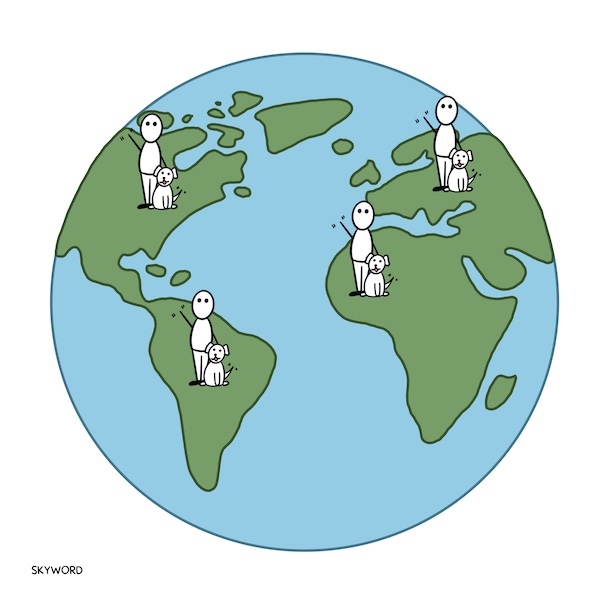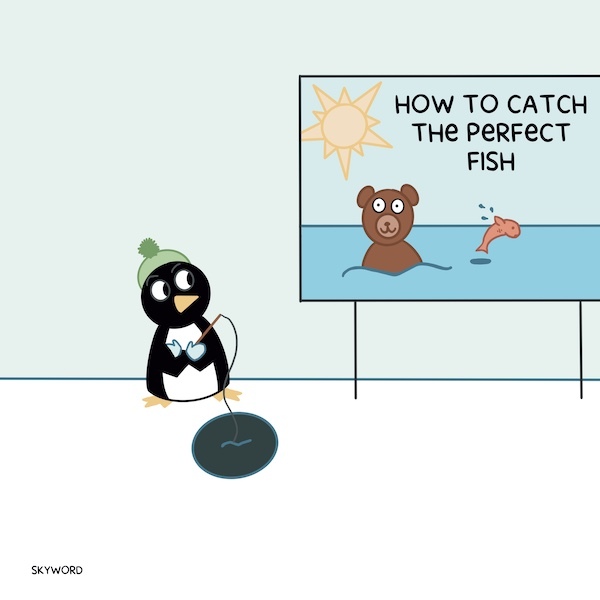Content Creation
Is Your Brand Lost in Translation? Here are 7 Must-Haves for Remarkable Global Content
By Andrew Wheeler on July 21, 2021
Subscribe to our monthly newsletter, Content & Context, to receive future insights and updates on the content marketing world from Skyword CEO, Andrew C. Wheeler.
Rio, a three-legged chocolate lab/pitbull mix, lives in Ohio with his dad, David.
David adopted Rio just before college, and the two have been inseparable ever since.
It was a hot summer night, just a month after graduating and moving into their first grown-up apartment together when David woke up to find Rio panting and convulsing at the foot of the bed.
Frantic, David turned to Google to figure out what to do.
The top search result was a Hill's Science Diet article that explained the symptoms of excessive heat exhaustion in dogs. David followed its advice to treat his overheated pup, and—to his relief—Rio came around.
The next day, David sent the brand a heartfelt note of thanks. Here's an excerpt:
Thanks to your contribution, ... I was able to take the right steps to cool my guy off and get him back down to normal. The cool, wet cloth under the armpits tip is what really helped him the most it seemed…I appreciate it so, so much.
Content moments like these are what make a brand more meaningful and memorable in customers' eyes.
But what if Rio and David lived in Japan, Germany, or Brazil?

Without a global strategy, even the most effective content remains a single-market event.
That heat exhaustion article was, in fact, transcreated and search optimized in Spanish for the Latin American market. No surprise, it became a top-performer in that region as well.
I've previously written about using content audits and refreshes to increase content ROI. Another method: taking blockbuster content from one market and adapting it for use in other regions.
The keyword here is adapting—which involves a heck of a lot more than just translation.
How to Go Beyond Translation
A couple of years ago, my good friend Matt Grotenstein and I co-delivered a presentation on how to scale great content across global markets.
Matt is a career expert in enterprise-level translation and localization. I came up in the world of search-driven marketing. Professionally, we've partnered for years to deliver top global content marketing services to Skyword clients. I'm thrilled to say he's recently joined Skyword full-time as Vice President of Global Brand Partnerships to continue to help more brands leverage content to stand out on a global scale.
As part of our presentation, Matt and I explained critical differences between global content adaptation approaches. Here are three of the most common:
-
Machine translation, or when software provides a literal translation from one language to another. This approach often requires a human to correct any errors from the generated text.
-
Human translation, or when a human translator provides a technically accurate translation of content from one language to another, including culturally correct word choice.
-
Transcreation, or when a human translator provides both a technically and culturally accurate translation of content—in addition to adapting other contextual elements to increase the content's local relevance.
The difference between these approaches looks a little something like this:

All this to say, your primary goal for content adaptation should be nailing the regional and cultural specifics that give your content more authentic context and meaning.
If you want to deliver market-specific content that engages, persuades, or entertains your target audience (and attracts regional search traffic), you need a transcreation partner who covers at least these seven critical elements of every asset:
-
Technical Accuracy. At a bare minimum, translation must accurately convey the message or instructions you're sharing.
-
Readability. The reading experience should be as fluid and pleasant as it is in the original—clear of any awkward syntax or unfamiliar turns of phrase.
-
Tone. The translation should match the casual/formal/humorous tone appropriate to that brand and market. Use idioms, terms, and cultural references that will resonate with the local population.
-
Local Sources. If the original piece references data or crosslinks to market-specific resources, these should be replaced with the equivalent local source. Otherwise, the content should be recast to incorporate credible regional-specific data.
-
Relevant Imagery. Any visuals should reflect regional audiences and locations.
-
Regional Keywords. Search terms and queries will vary between markets. Local keyword research must be applied to optimize the piece for in-market search.
-
Cultural Nuance. Any references to weather, culture, lifestyle, food, traditions, daily habits, etc. should be adapted to reflect regional norms and practices accurately. (This is a biggie!)

COVID-Induced Emphasis on Nuanced Global Marketing
Last week, my friend saw an Uber ad on the London tube that read: "enjoy actual face time."
A clever marketing campaign in theory, but the message was awkwardly out of sync with the sea of masked faces and the endless news loop featuring the reported surge in new cases.
As brands continue to calibrate their COVID-era communications for regions at different stages of reopening, creating content across markets calls for an even more nuanced approach that respects local policies and sensitivities.
Matt and I are teaming up again at the end of this month to chat about the what, why, and how of leveraging existing content across global markets.
What's more, Matt will be posting ongoing advice for brands eyeing smarter global expansion strategies. He'll cover topics from centralizing creation across regional markets to entering foreign markets and approaching culturally diverse segments within the U.S. market.
Follow Skyword on LinkedIn to check out these sessions as soon as they're live.
Featured image attribution: Kyle Glenn on Unsplash
